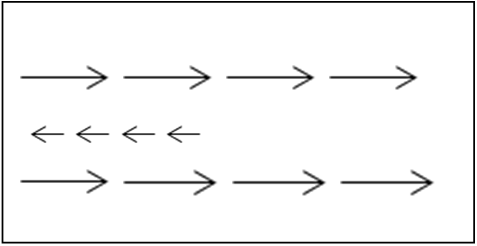This set of Nanotechnology Multiple Choice Questions & Answers (MCQs) focuses on “Nano Structured Material – Metals”.
1. In an atom, magnetic moment arises because of a number of factors. Which among the following is not one of them?
a) Spin moment of electron
b) Mass of electron
c) Orbital motion of electrons
d) External magnetic field
View Answer
Explanation: Magnetic moment of any magnetic system is the amount of torque it experiences when it is placed in a magnetic field. Magnetic moment in an atom arises due to the spin and orbital motion of electrons. It also arises due to a change in the orbital motion, in the presence of an applied magnetic field, H.
2. What is Magnetic susceptibility given by?
a) B/H
b) M/B
c) M/H
d) B/M
View Answer
Explanation: The ratio of M to H is called magnetic susceptibility where M denotes the magnetization (Magnetic moment per unit volume) and H denotes the field intensity of the magnetizing field applied.
3. What happens to the melting point of gold when its size is reduced from bulk to nanoscale?
a) Decreases
b) Increases
c) Fluctuates randomly
d) Remains unchanged
View Answer
Explanation: Melting point of gold nanoparticles is much reduced than that of bulk gold. This is because nanoparticles have greater surface area to volume ratio in comparison to bulk materials. This dramatically alters the thermal properties of the material.
4. What is the magnetic nature of Superconductors?
a) Ferromagnetic
b) Paramagnetic
c) Ferrimagnetic
d) Diamagnetic
View Answer
Explanation: Superconductors are the most exotic diamagnetic materials. These are metals that are super cooled and exhibit perfect diamagnetism and conductivity. The phenomenon of perfect diamagnetism where field lines are completely expelled from the material is called Meissner effect.
5. Which of the following properties in metals decrease when the size of the metal is reduced to nanoscale?
a) Electrical resistance
b) Elastic moduli
c) Hardness
d) Surface area
View Answer
Explanation: Metal nanoparticles show improved hardness, increased surface area and raised electrical resistance than the bulk metals. But their elastic moduli decreases drastically. For example: – Young’s modulus for Mg-nanoparticles with almost 12nm grain size is 3900 N/mm2. While the value changes to 4100 N/mm2 for polycrystalline Mg having size > 1micron.
6. Nanotechnology is not a recent development. It has been in use since ancient times. Which of the following historical object is not a product of nanotechnology?
a) Lycurgus cup
b) Damascus sword
c) Warren cup
d) Maya blue
View Answer
Explanation: Lycurgus cup reveals a brilliant red colour when light passes through it. This is due to the presence of gold-silver alloyed nanoparticles embedded in the glass. Damascus sword uses carbon nanotubes in its blade. Recent discovery revealed that Maya blue is a nanostructured pigment.
7. These magnetic materials have alternate spins but they are of smaller magnitudes than the rest and are unequal in number. Which materials are these?
a) Paramagnetic
b) Diamagnetic
c) Antiferromagnetic
d) Ferrimagnetic
View Answer
Explanation: Ferrimagnetic materials are similar to antiferromagnetic materials in having alternate spins. But they have smaller magnitudes than the rest. Moreover, they are unequal in number. The diagram below shows the arrangements of the magnetic moments in Ferrimagnetic materials.

8. Which of the following is not used in the production of gold nanoparticles?
a) Nitric acid
b) Alkanethiol
c) Sodium borohydride
d) Toluene
View Answer
Explanation: Gold nanoparticles, having a coating of thiol and embedded in an organic compound are formed when sodium borohydride in the presence of Alkanethiol reduces AuCl4–. The reduction occurring is a two phase water-toluene reduction process.
9. Which of the following statement is incorrect?
a) Copper is transparent at nanoscale
b) Colloidal gold is intense red in particle size range below 100nm
c) At nanoscale hardness and toughness of iron decreases rapidly
d) Gold nanoparticles are chemically very active
View Answer
Explanation: At nanoscale, hardness and toughness of metals are much more improved whereas their elastic moduli and electrical conductivity are reduced than the bulk metals.
10. Single domain ferromagnetic nanoparticles, with random magnetic orientations embedded in non-magnetic matrix display giant magneto-resistance.
a) True
b) False
View Answer
Explanation: Giant magneto-resistance is shown by single domain ferromagnetic nanoparticles that have random orientations of magnetization and are embedded in non-magnetic matrix. The magneto-resistance in these materials is isotropic. On application of a DC magnetic field, there is reduction in this resistance.
Sanfoundry Global Education & Learning Series – Nanotechnology.
To practice all areas of Nanotechnology, here is complete set of 1000+ Multiple Choice Questions and Answers.
If you find a mistake in question / option / answer, kindly take a screenshot and email to [email protected]
